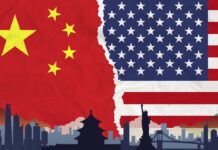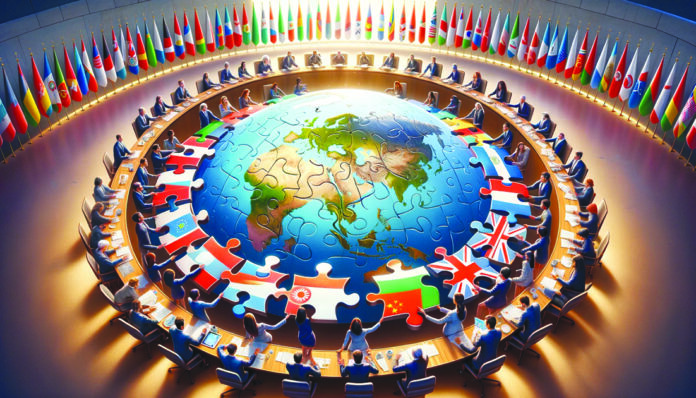Global geopolitics is undergoing a significant transformation. The once-dominant unipolar world order, centered on the US hegemony, is being replaced by a fragmented and multipolar system. This shift is driven by the expansion of coalitions like the BRICS, the rise of multi-alignment strategies by emerging powers, and the intensifying US-China rivalry. Each dynamic reflects a deepening complexity in international relations and heralds a potential restructuring of the global order.
The implications of this transformation are profound. Rising powers like China and India are leveraging the opportunities of this changing landscape to enhance their influence and strengthen their economies, while the USA faces a relative decline in its global dominance. Understanding these shifts is crucial to evaluate the future of global order.
The BRICS bloc— originally Brazil, Russia, India, China, and South Africa— has become a powerful platform for reshaping the global economic order. Its recent expansion, adding major energy exporters like Saudi Arabia and Iran, accentuates its intent to rival Western-led institutions like the G7. Trump’s recent tweet on threatening to impose a 100 percent tariff on the BRICS, further strengthens the argument of viewing BRICS as an emerging threat to economic hegemony of the USA. Collectively, BRICS countries now control more than 40 percent of the global population and nearly 30 percent of global GDP. It is worth noting these countries were colonies of the West, and contributed a big chunk to the global economy in the past. China has become the world’s second-largest economy with a GDP of over $14 trillion, driven by rapid industrialization and export growth, making it a global manufacturing powerhouse. Before colonization, China’s GDP was significantly lower, but it has grown exponentially since then.
India leads in information technology and software services, contributing 8 percent to its GDP and attracting significant foreign investment. Before colonization, India’s economy (Now India and Pakistan) was primarily agrarian, and contributed almost 25 percent in global GDP. Brazil, rich in oil, minerals, and agricultural products, is one of the largest producers of soybeans, coffee, and beef. Russia, a major exporter of oil and natural gas, significantly influences global energy markets. South Africa, a leading producer of platinum, gold, and other minerals, has a mining sector that contributes substantially to the global supply of these resources.
Moreover, most of the BRICS countries were once colonies of Western powers: Brazil by Portugal, India by Britain, South Africa by the Dutch and British. Russia faced periods of foreign influence, and China experienced significant intervention but was never fully colonized. These histories have shaped their current economic and political landscapes. The shared history of colonization among the BRICS countries provides them with a unique platform for cooperation, enabling them to fulfill the needs required to emerge as significant players in global power dynamics. By leveraging this common experience, these countries will develop stronger economic, political, and strategic alliances. Especially the historical bond between Russia, China and India matched with the geographical proximity, not only fosters solidarity but also strengthens their position in the global power structure, making them formidable contenders in shaping future geopolitics.
The way forward lies in fostering inclusive dialogue, strengthening multilateral institutions, and embracing global interconnectedness. Only through collaboration can the world build a future that is balanced, equitable, and sustainable.
However, a big question to BRICS credibility lies with India. India’s participation in BRICS, seems to contradict its involvement in the QUAD, a strategic forum with the USA, Japan, and Australia aimed at countering China’s influence in the Asia-Pacific, which is mainly because of its expanding economy. This dual alignment depicts India as trying to play both sides to maximize its benefits, which undermines its credibility with both groups. This balancing act enables India to access Chinese trade opportunities while leveraging the US military technology and strategic support to counterbalance China’s influence in the Asia-Pacific. Given this, China’s Belt and Road Initiative (BRI), for instance, aligns with BRICS’s goals of infrastructure development, providing China access to main markets, such as Europe and resources in Asia, Africa, and Latin America. Meanwhile, India leverages BRICS as a platform to challenge Western trade policies, secure investments for infrastructure, and assert its leadership in the Global South. China, too, benefits from multi-alignment.
The trade volume between China and Africa reached a record $282 billion in 2023. Although, such strategies as China’s economic partnerships and investments weaken the US ability to isolate or pressure rising powers, further diffusing global power. For decades, the USA maintained its hegemony through control of global financial systems, military alliances like NATO, and soft power institutions such as the IMF and World Bank. Today, these pillars face mounting challenges from counterbalancing institutions and alliances like BRICS, signaling a shift in global power dynamics. Economically, the decline of the dollar’s dominance in international trade poses a significant threat to the US influence. The dollar’s role as the global reserve currency has long provided America with unparalleled financial leverage, allowing it to impose sanctions, control global trade flows, and maintain a robust domestic economy. De-dollarization efforts by BRICS, coupled with emerging alternative currencies like the yuan, could undermine this advantage, forcing the USA to compete on less favourable terms. For example, in 2023, one-fifth of oil trades were conducted using the Chinese Yuan and Indian Rupee, becoming the top used non-dollar currencies. Countries that once relied heavily on US security guarantees, such as Saudi Arabia and Turkey, are now exploring partnerships with China and Russia.
The world is entering a multipolar era, driven by BRICS, multi-alignment strategies, and the decline of US dominance. Rising powers like India and China are leveraging this transition to assert global influence and address inequities, challenging traditional US leadership. Platforms like BRICS enable these nations to redefine global governance. However, this shift risks fragmenting international systems, complicating efforts to address shared challenges like climate change and inequality. The way forward lies in fostering inclusive dialogue, strengthening multilateral institutions, and embracing global interconnectedness. Only through collaboration can the world build a future that is balanced, equitable, and sustainable.





















